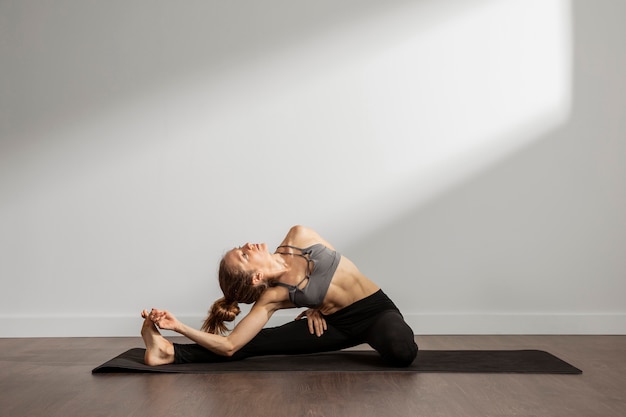
Yoga isn’t just about flexible limbs; it can significantly boost memory, heart, and bone health. Nowadays, Brits are spending about £790 million annually on yoga classes and equipment.
While yoga is sometimes seen as quirky with new variations like rage yoga, paddle-board yoga, and even dog yoga, science is increasingly supporting its benefits. For instance, UCLA researchers found that a three-month course of yoga and meditation outperformed memory exercises in reducing age-related brain decline and improving sleep in breast cancer survivors.
Lucy Edge, a 53-year-old former advertising exec, discovered the mental benefits of yoga firsthand. She battled depression by taking a six-month break and traveling to India to study yoga. Although she didn’t achieve a “yoga goddess” body, she returned happier and more content. Inspired by her experience, Lucy has written three books about yoga and started Yoga Meds on her website Yogaclicks.com, showcasing over 300 clinical trials on yoga’s health benefits.
So, how can yoga improve your health? Here are some highlights:
Memory: UCLA research involving 25 adults over 55 found that 12 weeks of yoga and meditation improved spatial and visual memory more than traditional memory exercises. They also experienced reduced depression, anxiety, and better stress resilience. In the study, participants practiced one hour of Kundalini yoga weekly and 20 minutes daily of Kirtan Kriya, a meditation involving chanting and visualization.
Heart Health: A 2014 review in the European Journal of Preventative Cardiology highlighted that yoga might lower heart disease risk as effectively as brisk walking. Yoga reduces stress, which is a significant factor in heart disease. Dr. Mike Knapton of the British Heart Foundation noted that yoga can help manage blood pressure, cholesterol, and weight.
Stress Reduction: Yoga poses supported by bolsters and cushions can significantly reduce stress, giving the nervous system a much-needed break. Restorative yoga, which involves holding postures for extended periods, is particularly effective.
Back Pain and Injury Prevention: Physiotherapist and yoga teacher Sarah Shone developed yoga classes for back pain relief. An impressive 87% of participants reported reduced pain. Yoga also strengthens the pelvic floor muscles and increases bone density.
Starting Out: If you’re new to yoga, inform your instructor about any health conditions and start with gentle styles like Hatha or Iyengar. These styles are less intense and more beginner-friendly. For specific issues like back pain, consult your doctor about potential subsidized yoga courses.
Yoga Gear: Choosing the right yoga mat is essential. Consider where you’ll store it, how much you’ll move it, your height, and the mat’s thickness. A thicker mat can protect your joints better. For example, the Valka Yoga Elephant Cork mat is a solid choice. It’s eco-friendly, durable, and offers good joint support.
Yoga Props: Yoga blocks can help you achieve difficult poses by providing extra length and stability. Cork blocks, although heavier than foam ones, offer better grip and are ideal for maintaining balance.
Remember, everyone can benefit from yoga, whether you’re flexible or not. Beginners might try Yin or Restorative yoga, while those seeking more energy can opt for Vinyasa Flow. Iyengar yoga focuses on alignment and uses props, making it great for starters. Anusara yoga combines alignment with flowing movements to upbeat music, and Yoga Therapy is designed to aid in recovery from injury or illness.
Lucy Edge’s latest book, “Down Dog Billionaire,” explores further aspects of yoga and its benefits. If you want more health and wellness tips, consider subscribing to relevant newsletters for regular updates.




